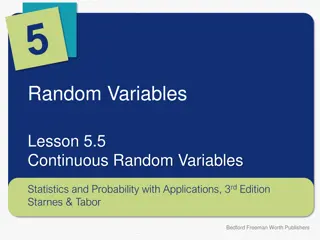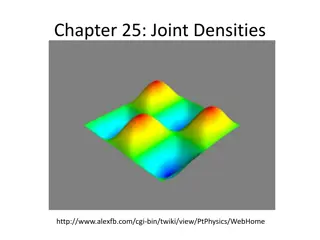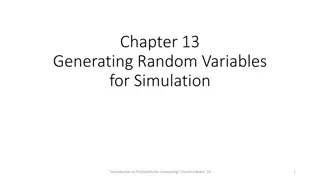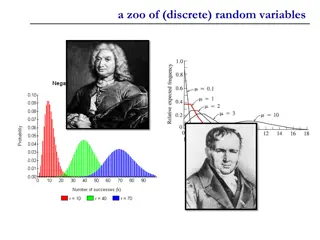Understanding Named Continuous Random Variables
Comparison and examples of named continuous random variables like Uniform, Exponential, Gamma, Beta, Normal distributions. Exploring Uniform distribution with bus arrival scenarios and cost implications.
Download Presentation

Please find below an Image/Link to download the presentation.
The content on the website is provided AS IS for your information and personal use only. It may not be sold, licensed, or shared on other websites without obtaining consent from the author. Download presentation by click this link. If you encounter any issues during the download, it is possible that the publisher has removed the file from their server.
E N D
Presentation Transcript
Part VI: Named Continuous Random Variables 1 http://www-users.york.ac.uk/~pml1/bayes/cartoons/cartoon08.jpg
Comparison of Named Distributions discrete continuous Continuous Uniform, Exponential, Gamma, Beta, Normal Bernoulli, Binomial, Geometric, Negative Binomial, Poisson, Hypergeometric, Discrete Uniform 2
Chapter 30: Continuous Uniform R.V. http://www.six-sigma-material.com/Uniform-Distribution.html 3
Uniform distribution: Summary Things to look for: constant density on a line or area Variable: X = an exact position or arrival time Parameter: (a,b): the endpoints where the density is nonzero. Density: CDF: 0 ? < ? 1 ? ? ? ? 1 ? ? ? ? ? ? ??? = ??? = ? ? 0 ???? ? < ? ??? ? =(? ?)2 ? ? =? + ? , 4 2 12
Example: Uniform Distribution (Class) A bus arrives punctually at a bus stop every thirty minutes. Each morning, a bus rider leaves her house and casually strolls to the bus stop. a) Why is this a Continuous Uniform distribution situation? What are the parameters? What is X? b) What is the density for the wait time in minutes? c) What is the CDF for the wait time in minutes? d) Graph the density. e) Graph the CDF. f) What is the expected wait time? 5
Example: Uniform Distribution (Class) A bus arrives punctually at a bus stop every thirty minutes. Each morning, a bus rider leaves her house and casually strolls to the bus stop. g) What is the standard deviation for the wait time? h) What is the probability that the person will wait between 20 and 40 minutes? (Do this via 3 different methods.) i) Given that the person waits at least 15 minutes, what is the probability that the person will wait at least 20 minutes? 6
Example: Uniform Distribution 0.04 0.03 0.02 0.01 0.00 -10 10 30 1 0.8 0.6 0.4 0.2 0 7 -10 10 30
Example: Uniform Distribution (Class) A bus arrives punctually at a bus stop every thirty minutes. Each morning, a bus rider leaves her house and casually strolls to the bus stop. Let the cost of this waiting be $20 per minute plus an additional $5. a) What are the parameters? b) What is the density for the cost in minutes? c) What is the CDF for the cost in minutes? d) What is the expected cost to the rider? e) What is the standard deviation of the cost to the rider? 8
Chapter 31: Exponential R.V. File:Exponential pdf.svg File:Exponential cdf.svg http://en.wikipedia.org/wiki/Exponential_distribution 9
Exponential Distribution: Summary Things to look for: waiting time until first event occurs or time between events. Variable: X = time until the next event occurs, X 0 Parameter: : the average rate Density: ??? = ?? ?? 0 CDF: ??? = 1 ? ?? ? > 0 ???? ? > 0 ???? 0 ? ? =1 ??? ? =1 ?, ?2 10
Example: Exponential R.V. (class) Suppose that the arrival time (on average) of a large earthquake in Tokyo occurs with an exponential distribution with an average of 8.25 years. a)What does X represent in this story? What values can X take? b)Why is this an example of the Exponential distribution? c) What is the parameter for this distribution? d)What is the density? e)What is the CDF? f) What is the standard deviation for the next earthquake? 11
Example: Exponential R.V. (class, cont.) Suppose that the arrival time (on average) of a large earthquake in Tokyo occurs with an exponential distribution with an average of 8.25 years. g) What is the probability that the next earthquake occurs after three but before eight years? h)What is the probability that the next earthquake occurs before 15 years? i) What is the probability that the next earthquake occurs after 10 years? j) How long would you have to wait until there is a 95% chance that the next earthquake will happen? 12
Example: Exponential R.V. (Class, cont.) Suppose that the arrival time (on average) of a large earthquake in Tokyo occurs with an exponential distribution with an average of 8.25 years. k) Given that there has been no large Earthquakes in Tokyo for more than 5 years, what is the chance that there will be a large Earthquake in Tokyo in more than 15 years? (Do this problem using the memoryless property and the definition of conditional probabilities.) 13
Minimum of Two (or More) Exponential Random Variables Theorem 31.5 If X1, , Xn are independent exponential random variables with parameters 1, , n then Z = min(X1, , Xn) is an exponential random variable with parameter 1+ + n. 14
Chapter 37: Normal R.V. http://delfe.tumblr.com/ 15
Normal Distribution: Summary Things to look for: bell curve, Variable: X = the event Parameters: X = the mean ?? Density: ??? =? 2??2 ? ? = X, 2= ? ? ???????? (? ??)2(2?2) ,? ? 2 ??? ? = ?? 16
PDF of Normal Distribution (cont) File:Normal distribution pdf.svg http://commons.wikimedia.org/wiki/File:Normal_distribution_pdf.svg 17
PDF of Normal Distribution http://www.oswego.edu/~srp/stats/z.htm 18
PDF of Normal Distribution (cont) X 0 0.2 File:Normal distribution pdf.svg X ( 2) 0.5 X 0 1 X 0 5 http://commons.wikimedia.org/wiki/File:Normal_distribution_pdf.svg 20
Procedure for doing Normal Calculations 1) Sketch the problem. 2) Write down the probability of interest in terms of the original problem. 3) Convert to standard normal. 4) Convert to CDFs. 5) Use the z-table to write down the values of the CDFs. 6) Calculate the answer. 21
Example: Normal r.v. (Class) The gestation periods of women are normally distributed with = 266 days and = 16 days. Determine the probability that a gestation period is a) less than 225 days. b) between 265 and 295 days. c) more than 276 days. d) less than 300 days. e) Among women with a longer than average gestation, what is the probability that they give birth longer than 300 days? 22
Example: Backwards Normal r.v. (Class) The gestation periods of women are normally distributed with = 266 days and = 16 days. Find the gestation length for the following situations: a) longest 6%. b) shortest 13%. c) middle 50%. 23
Chapter 36: Central Limit Theorem (Normal Approximations to Discrete Distributions 36.4, 36.5) http://nestor.coventry.ac.uk/~nhunt/binomial /normal.html http://nestor.coventry.ac.uk/~nhunt/poisson /normal.html 26
Continuity Correction - 1 27 http://www.marin.edu/~npsomas/Normal_Binomial.htm
Continuity Correction - 2 W~N(10, 5) X ~ Binomial(20, 0.5) 28
Continuity Correction - 3 Discrete a < X a + 0.5 < X a X a 0.5 < X X < b X b Continuous X < b 0.5 X < b + 0.5 29
Example: Normal Approximation to Binomial (Class) The ideal size of a first-year class at a particular college is 150 students. The college, knowing from past experience that on the average only 30 percent of these accepted for admission will actually attend, uses a policy of approving the applications of 450 students. a) Compute the probability that more than 150 students attend this college. b) Compute the probability that fewer than 130 students attend this college. 31
Chapter 32: Gamma R.V. http://resources.esri.com/help/9.3/arcgisdesktop/com/gp_toolref /process_simulations_sensitivity_analysis_and_error_analysis_modeling /distributions_for_assigning_random_values.htm 32
Gamma Distribution Generalization of the exponential function Uses probability theory theoretical statistics actuarial science operations research engineering 33
Gamma Function t 1 = = x (t) x e dx,t 0 0 (t + 1) = t (t), t > 0, t real (n + 1) = n!, n > 0, n integer 1 (2n)! n 2 n!2 + + = = 2n 34
Gamma Distribution: Summary Things to look for: waiting time until rth event occurs Variable: X = time until the rth event occurs, X 0 Parameters: r: total number of arrivals/events that you are waiting for : the average rate Density: ?? (?)?? 1? ?? 0 ???? ? ? =? ? ?2 ? > 0 ??? = ?,??? ? = ? 1(??)? 1 ? ?? ? > 0 ???: ??? = ?! ?=0 0 ???? 35
Gamma Random Variable File:Gamma distribution pdf.svg k = r ? =1 ? http://en.wikipedia.org/wiki/File:Gamma_distribution_pdf.svg 36
Chapter 33: Beta R.V. http://mathworld.wolfram.com/BetaDistribution.html 37
Beta Distribution This distribution is only defined on an interval standard beta is on the interval [0,1] The formula in the book is for the standard beta uses modeling proportions percentages probabilities 38
Beta Distribution: Summary Things to look for: percentage, proportion, probability Variable: X = percentage, proportion, probability of interest (standard Beta) Parameters: , Density: ??? ? 1 ? 1 (? + ?) (?) (?) ? ? ? ? ? ? ? ? 1 ? ? ? = ? ? 0 ???? Density: no simple form When A = 0, B = 1 (Standard Beta) ? ? + ?,??? ? = ?? ? ? = 39 ? + ?2(? + ? + 1)
Shapes of Beta Distribution http://upload.wikimedia.org/wikipedia/commons/9/9a/Beta_distribution_pdf.png 40 X
Other Continuous Random Variables Weibull exponential is a member of family uses: lifetimes lognormal log of the normal distribution uses: products of distributions Cauchy symmetrical, flatter than normal 41
Chapter 37: Summary and Review of Named Continuous R.V. http://www.wolfram.com/mathematica/new-in-8/parametric-probability-distributions /univariate-continuous-distributions.html 42
Summary of Continuous Distributions Name Density, fX(x) Domain CDF, FX(x) ?(X) Var(X) Parameters What X is When used 43
Expected values and Variances for selected families of continuous random variables. Family Parameter(s) Expectation Variance + a b 2 (b a) Uniform a,b 2 12 1 1 Exponential 2 Normal 44























